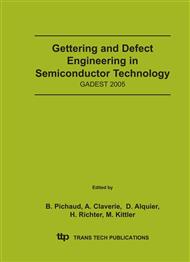p.77
p.83
p.91
p.97
p.103
p.109
p.115
p.125
p.133
Effect of Oxygen Precipitates on the Surface-Precipitation of Nickel on Cz-Silicon Wafers
Abstract:
This paper presents a model for the analysis of the surface nucleation and growth of Ni silicide on silicon wafers contaminated by Ni. The model can additionally be used to characterize the gettering reaction of Ni induced by oxygen precipitates. We also discuss the relation between the surface precipitation of Ni silicide and the gettering ability of oxygen precipitate. The surface precipitation of Ni silicide depends on the total surface area of oxide precipitates. When the total surface area of the oxide precipitates exceeds the critical value, the surface precipitation is rapidly suppressed. Our model can explain the phenomenon of the gettering threshold in the following manner. 1) The gettering of Ni by oxygen precipitates is a reaction-limited process at the interface between oxygen precipitate and silicon, as Sueoka proposed. 2) The residual Ni concentration in this reaction-limited gettering process continuously decreases as the total surface area of the oxide precipitates increases. 3) The surface precipitation of Ni silicide is rapidly suppressed when the residual Ni concentration falls below the critical concentration. Our calculation results correspond well with the experimental results.
Info:
Periodical:
Pages:
103-108
Citation:
Online since:
December 2005
Authors:
Keywords:
Price:
Сopyright:
© 2005 Trans Tech Publications Ltd. All Rights Reserved
Share:
Citation:


